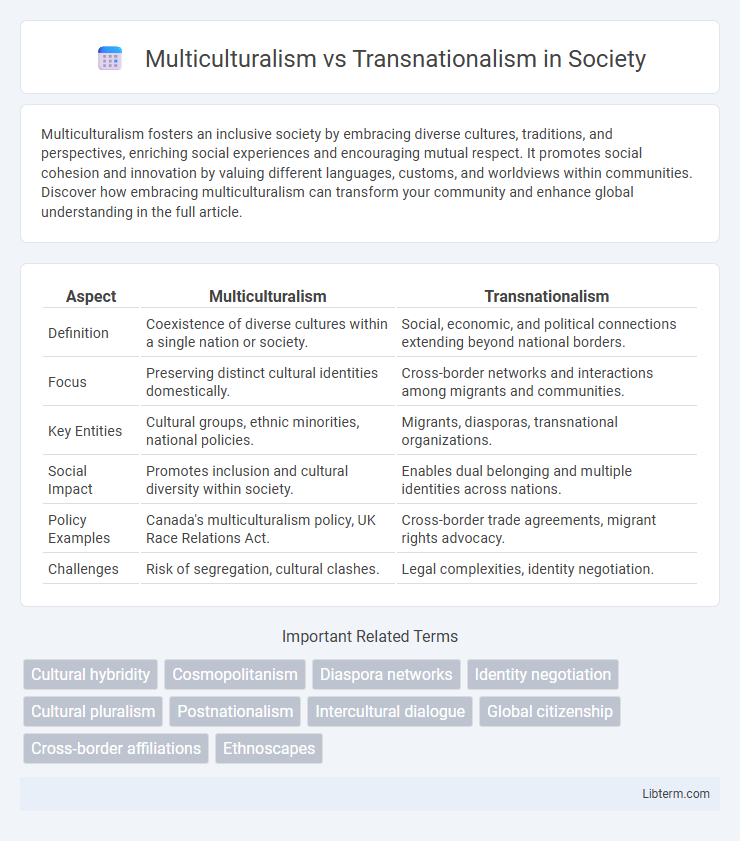Multiculturalism fosters an inclusive society by embracing diverse cultures, traditions, and perspectives, enriching social experiences and encouraging mutual respect. It promotes social cohesion and innovation by valuing different languages, customs, and worldviews within communities. Discover how embracing multiculturalism can transform your community and enhance global understanding in the full article.
Table of Comparison
| Aspect | Multiculturalism | Transnationalism |
|---|---|---|
| Definition | Coexistence of diverse cultures within a single nation or society. | Social, economic, and political connections extending beyond national borders. |
| Focus | Preserving distinct cultural identities domestically. | Cross-border networks and interactions among migrants and communities. |
| Key Entities | Cultural groups, ethnic minorities, national policies. | Migrants, diasporas, transnational organizations. |
| Social Impact | Promotes inclusion and cultural diversity within society. | Enables dual belonging and multiple identities across nations. |
| Policy Examples | Canada's multiculturalism policy, UK Race Relations Act. | Cross-border trade agreements, migrant rights advocacy. |
| Challenges | Risk of segregation, cultural clashes. | Legal complexities, identity negotiation. |
Understanding Multiculturalism: Definition and Core Principles
Multiculturalism refers to the coexistence of diverse cultural groups within a society, emphasizing the recognition, respect, and preservation of distinct cultural identities. Core principles include cultural pluralism, equal opportunity, and inclusive policies that promote social integration while valuing diversity. This approach fosters mutual understanding and combats discrimination by encouraging dialogue and interaction among different cultural communities.
What Is Transnationalism? Key Concepts Explained
Transnationalism refers to the process by which immigrants create and maintain social, economic, and political connections that span across national borders. Key concepts include cross-border networks, dual or multiple citizenships, and the continuous exchange of information, goods, and cultural practices between homeland and host country. This framework emphasizes the fluidity of identities and social fields that challenge traditional notions tied strictly to one nation-state.
Historical Context: Origins of Multiculturalism and Transnationalism
Multiculturalism emerged in the mid-20th century as a response to post-World War II immigration patterns, emphasizing the coexistence of diverse cultural identities within nation-states. Transnationalism developed later, in the late 20th century, driven by globalization, advanced communication technologies, and increased cross-border migration, highlighting the fluid connections between people, cultures, and economies across national boundaries. Both concepts challenge traditional notions of fixed national identity but originate from different historical contexts and socio-political dynamics.
Key Differences Between Multiculturalism and Transnationalism
Multiculturalism emphasizes the coexistence of diverse cultural groups within a single nation-state, promoting cultural recognition and inclusion, whereas transnationalism focuses on the connections and interactions of people across national borders, highlighting cross-border networks and identities. Multiculturalism seeks to manage cultural diversity within national boundaries through policies supporting cultural rights, while transnationalism studies how migrants maintain social, economic, and political ties across countries. The key difference lies in multiculturalism's focus on internal national diversity compared to transnationalism's emphasis on cross-border, multi-location social fields.
Societal Impact: Integration, Identity, and Belonging
Multiculturalism promotes social cohesion by encouraging the coexistence of diverse cultural identities within a shared national framework, fostering a sense of belonging through recognition and respect for cultural differences. Transnationalism transcends national borders, enabling individuals to maintain multiple identities and affiliations that shape their social networks and influence integration processes across countries. Both paradigms impact societal integration by challenging traditional notions of identity, while offering dynamic frameworks for belonging in increasingly globalized communities.
Policy Approaches: Comparing Multicultural and Transnational Models
Multiculturalism policies emphasize the recognition and accommodation of diverse cultural identities within a single nation-state, promoting cultural preservation and equal rights for minority groups through legal frameworks and public services. Transnationalism, by contrast, focuses on maintaining connections beyond national borders, supporting migrant communities through policies that facilitate cross-border social, economic, and political participation. Comparative policy analysis reveals that multicultural models prioritize integration within national boundaries, while transnational approaches foster dual or multiple attachments, influencing immigration, citizenship, and social welfare programs.
Challenges and Criticisms: Multiculturalism vs Transnationalism
Multiculturalism faces challenges such as reinforcing ethnic silos and hindering social cohesion by emphasizing distinct cultural identities within national borders. Transnationalism is criticized for complicating citizenship and loyalty, as individuals navigate multiple national affiliations that may undermine political integration. Both frameworks struggle with balancing individual cultural expression and fostering inclusive, cohesive societies in increasingly globalized contexts.
Case Studies: Countries Embracing Each Approach
Canada exemplifies multiculturalism by officially recognizing and celebrating diverse cultural identities within its society, promoting policies that support cultural preservation alongside national unity. In contrast, the European Union demonstrates transnationalism by facilitating cross-border cooperation and emphasizing shared political, economic, and social frameworks that transcend individual nation-states. Germany's dual approach incorporates multicultural policies to integrate immigrants while fostering transnational networks with Turkish diaspora communities through cultural exchanges and political participation.
The Role of Globalization in Shaping Identities
Globalization accelerates the interaction between diverse cultures, fostering multiculturalism by promoting cultural coexistence within national boundaries. Simultaneously, it enables transnationalism by facilitating connections across borders, where individuals maintain multiple cultural affiliations and identities beyond a single nation-state. This dynamic interplay shapes complex identities that transcend traditional national frameworks, reflecting both local diversity and global linkages.
Future Perspectives: Toward Inclusive Societies
Multiculturalism and transnationalism both shape future perspectives on inclusive societies by promoting cultural diversity and cross-border connections, respectively. Multiculturalism emphasizes coexistence within national borders, fostering policies that celebrate ethnic pluralism, while transnationalism extends beyond, encouraging continuous social, economic, and political ties across countries. Embracing hybrid identities and flexible community affiliations can advance social cohesion and equitable opportunities in increasingly interconnected global environments.
Multiculturalism Infographic

 libterm.com
libterm.com